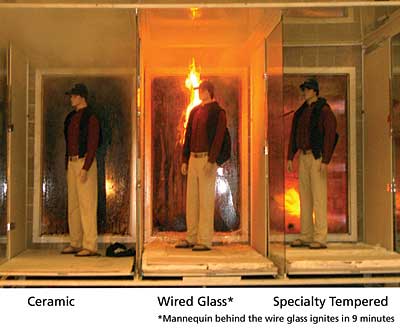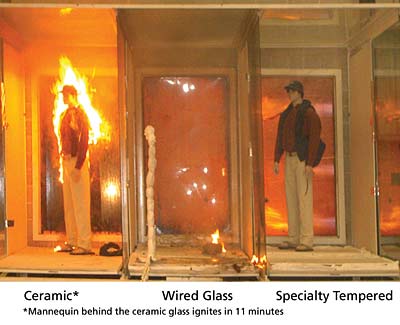Fire-Protective vs. Fire-Resistive Glazing: Radiant Heat, Tests and Ratings
Code Considerations for Fire-Protective Glazing: "The 60-Minute Window"
Familiarity with the codes is critical, especially when architects are considering 60-minute fire-rated glazing. Many architects have assumed that 60-minute windows are accepted for use to protect openings as provided by codes, as long as they adhere to allowed uses and size and area limits. In fact, the building codes consistently limit windows to applications rated 45-minutes or less. According to the codes, there is no 60-minute window at all.
So the concept of "60-minute windows" and "90-minute windows"-though popularized in casual building design lexicon-does not exist. What does that mean? It means that when architects design and specify 60-minute and 120-minute fire-rated glazed assemblies, these constructions must be fire-resistive. That is, they must limit temperature and the risk of fire spread on the non-fire side of the wall.
For that reason, the design must limit risk by means other than merely the right choice of glazing. Safe separation distances, careful designs of openings and other design tools are what make the best fire-resistive assemblies-and the best compartmentalized, safest buildings.
Glazing Rated Under 60 Minutes: Key Concerns
There are other considerations that are vital for architects to understand before specifying glazing with fire ratings under 60 minutes.
For example, fire-rated glazing is permitted in sidelight and transom frames rated 45-minutes or less. Glazing are only rated for use in 60-minute assemblies if they are tested as per ASTM E119 as a wall assembly and under door-test standards. The wall test criteria in ASTM E119 includes temperature rise limits. This requirement applies to windows, sidelights and transoms.
 |
This runs counter to the seemingly reasonable belief that if a 45-minute fire-protective rating is the code minimum, then a fire protective rating for 60 minutes must be that much better. However, fire-protection experts and engineers caution that this is not the case. The reason is radiant heat. During that extra 15 minutes, the uncontrolled transfer of radiant heat to the non-fire side of the wall can trigger combustion of flammable materials. This effect does not contain fire; it spreads fire.
Another difficult area related to 60-minute glazing is the question of glazed sidelights and transoms. In one-hour-rated doors and one-hour-rated occupancy walls, many architects believe that glazed sidelights are permitted as long as they meet size and area limits. However, they are not allowed in one-hour-door assemblies.
 |
Listings for fire door frames-in UL, for example-refer to NFPA 80, which requires solid side panels and transoms in frames for assemblies with a rating of 45 minutes or more. This precludes glazed sidelights, although up to 100 square inches of glazing may be permitted in the doors for ratings of up to 90 minutes.
The 45-minute limit for the rating of window assemblies is also given in UBC: Standard No. 43-4, Section 43.301, which is referenced in Section 4306 (i). In NFPA 80, size and area limits are specified for lights in a window assembly rated 45 minutes, given in Chapter 13, Fire Windows. As long as size limits are followed, door assemblies rated 45 minutes could even include more than one pane of glass.
The question of the 60-minute window comes down to radiant heat transfer. For a 60-minute rating as a separated fire-resistive assembly, windows must be tested as per UBC as a wall assembly and meet the requirements for heat transmission. Most transparent glazing will not conform to this standard. Fire-resistive glazing does comply, however, and the specifier and designer should ensure that the 60-minute-rated glazing also meets the requirements for heat transmission.









